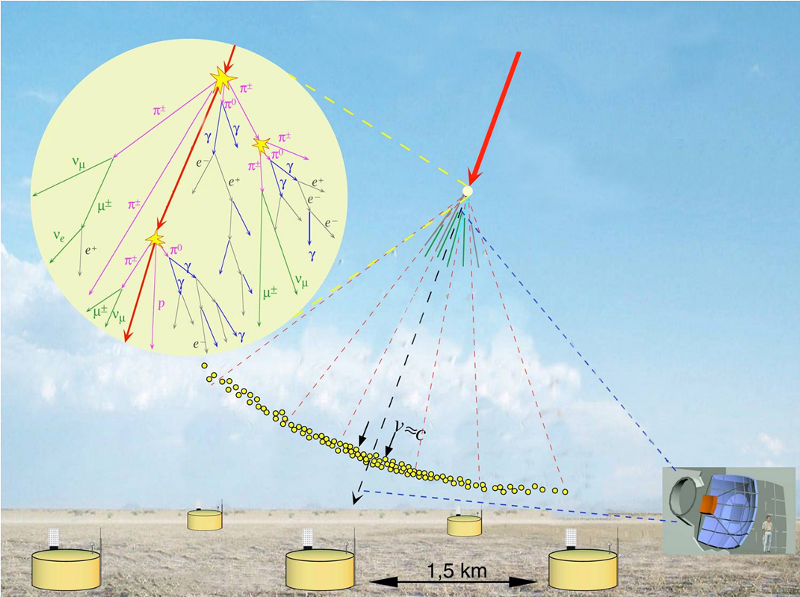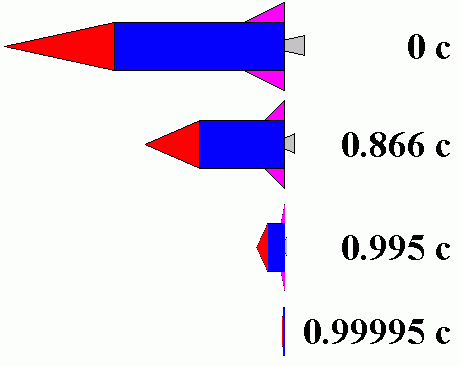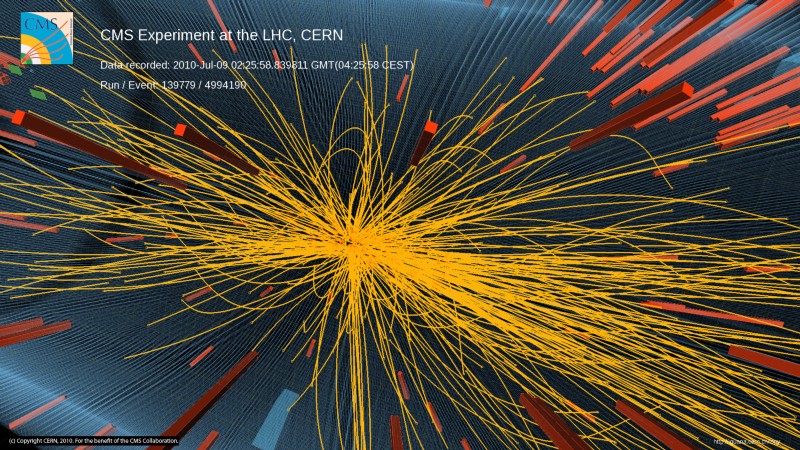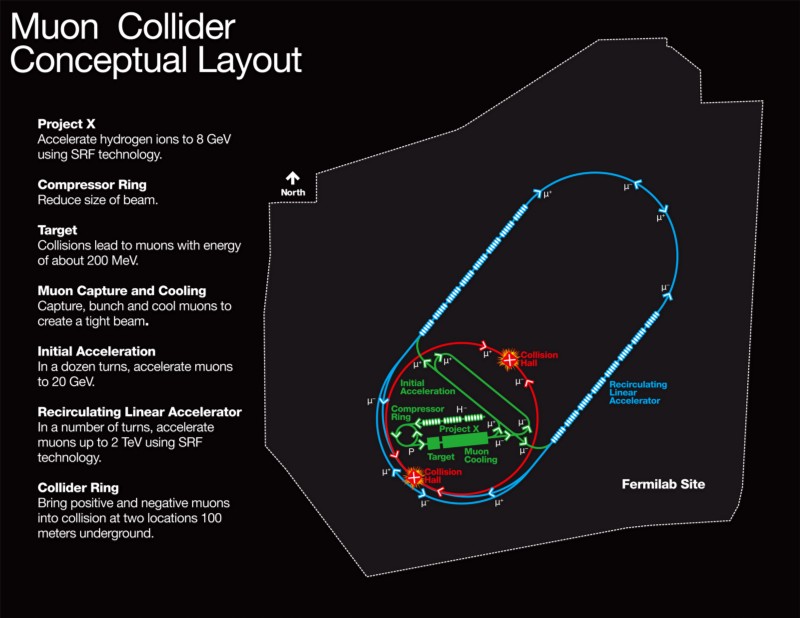Ask Ethan # 90: Muons, Relativity and New Record
As one of the first tests of the special theory of relativity, it can lead to the creation of the greatest particle accelerator of all time.
Each natural phenomenon that we observed in the entire Universe consists of the same particles: protons, neutrons and electrons, together with photons. At least, it is usually considered so, but along with them a huge amount of neutrinos, antineutrinos, a supermassive amount of dark matter, as well as a set of unstable high-energy particles are involved. One of them, muon, was the subject of a very interesting question from the user MegaN00B:
Recently you mentioned in your blog that cosmic rays, when entering the atmosphere, generate particles (it seems to me, muons), and how relativity helps muons go further than they could, as they must disintegrate before they reach the surface.
What would this path look like from the point of view of the muon?
Let's start over, and tell you about the muons.
')

Practically everything that we know - atoms, molecules, planets, stars, nebulae, galaxies - is created from several well-known fundamental particles: photons, electrons, gluons, and also quarks making protons and neutrons. There are still neutrinos and antineutrinos that rarely interact with matter, as well as dark matter, whose presence we know only due to gravity. Everything else that can be created, all other fundamental particles are terribly unstable, that is, they break up with time into something more light and stable.
Of all these unstable particles, the muon is closest to the stable ones, since it lives a “long” life of 2.2 microseconds on average, which is orders of magnitude longer than the others. Muon is like a cousin of an electron, only heavier, but has the same properties:
• lepton number
• electric charge,
• spin,
• magnetic moment,
except that it is 206 times heavier, and after its quantum fate is solved, it decays into an electron and two neutrinos.

The strange thing is that if you stretch your arm parallel to the Earth, one muon will pass through it every second. These muons are born in the upper part of the atmosphere, into which high-energy particles, also known as cosmic rays, are constantly crashing. These are mostly protons, but very high energies: they crash into atoms so strongly that it causes wide air showers of particles - the occurrence of matter / antimatter pairs, as well as heavy unstable particles like pions, which can also decay (for example, the same muons ).

This should not surprise you: if you have heard about E = mc 2 , you realize that it is possible to spontaneously create new particles, pushing two particles together at fairly high speeds. Let's calculate: even if the particles move almost at the speed of light, 300 000 km / s, and live 2.2 microseconds, they must pass no more than 660 meters before decaying.
However, I say that these particles are created in the upper part of the atmosphere, about 100 km from the Earth, or 100,000 meters! From our point of view, the muon should not reach the earth. However, Einstein saves everything - the closer to the speed of light objects move, the slower their watches go.

From our point of view, a muon moving from 99.9995% of the speed of light will experience a time delay of 1000 times compared to a resting muon. So instead of 660 meters, it can fly 660 kilometers before it disintegrates. This difference for muons with an average lifetime of 2.2 μs means that instead of one chance out of 10 66 to reach you (they would have such a chance without slowing down time) they get a 86% chance of doing so.
And what would it look like from the side of the muon? From his point of view, time flows normally, he appeared in the upper atmosphere and descended to the ground. But "to the ground" for him means not the same as for us!

Muon feels that his time is flowing normally, but the whole world is moving towards him at a speed of 99.9995% of the light. In addition to slowing down the time, the muon sees the effects of reducing the length, that is, the distance of 100 km, which he needs to go, seems to him to be 1000 times smaller, that is, like 100 meters. And he has a 86% chance of reaching the ground before it disintegrates, even if you count from his point of view.
Awareness of all this leads us to the temptation: if, driving the muon almost to the speed of light, we lengthen its lifetime, perhaps we can use it to create the ideal particle accelerator!

Usually in accelerators / colliders we use a stable particle (or antiparticle), like an electron, positron, proton, antiproton. With the help of the electric field we accelerate the particle, and with the help of the magnetic field - we bend its path. The ring is of great importance, since the same “route” can be used repeatedly, accelerating the particle to higher and higher energies and to speeds that differ from the light one much less than one kilometer per second.
But there is a problem. We would like to achieve the same energies as are available at the LHC, at the electron-positron colliders. When two protons collide in the LHC, the collision energy is distributed not only between all three quarks in each proton, but also between all gluons deep inside. You not only lose almost all the energy that you have gained so hard, you also get a bunch of "garbage", because all these quarks with gluons create complete chaos in the detector.

But at electron-positron colliders it is physically impossible to achieve the same energies as at proton ones. The same tunnel, 27 km long, which is now working in the LHC, was previously used in the Large Electron-Positron Collider. But while at the LHC, energies of 13 TeV, or 13,000,000,000,000 eV could be achieved, energies of 114 GeV, or 114,000,000,000 eV could be achieved at BAPK. Where does the difference a hundred times? Not because of the size of the ring (they are identical), not because of the strength of the magnets (if there were today's magnets in the past, nothing would have changed), but because charged particles are accelerated by bending their trajectory in a magnetic field, and emit.

This effect is known as synchrotron radiation, and it causes charged particles to lose energy inversely proportional to the fourth power of the mass. This means that an electron weighing 1836 times less than a proton loses energy 10 13 times faster! A pity, because if we could push electrons and positrons at the same energies as hadrons, we could more accurately measure the higher energies of the centers of mass and get better data in the detector.
But if we could take advantage of the time delay in muons, we could build a muon collider, because 206 times more than an electron, the weight will allow us to lose two billion times less energy than an electron loses after each pass through the ring.

As long as there are obstacles that must be overcome to build a muon collider, but if we can reduce the muons (and antimuons) into a parallel beam and run them into the accelerator ring with a sufficient initial speed, we can accelerate them to 99.999% of the speed of light, push them and open even more amazing facts about the Universe - including high-precision physics and the decay of particles such as the Higgs boson and the top quark.
The working spring conference on the Fermlab muon accelerator program has just (May 2015) ended. At the top, you see a prototype of a 201 MHz MICE radio module, which accelerates muons by 11 MeV per meter of length, simultaneously reducing the lateral velocity, which is necessary to maintain the parallelism of the beam. This technique is known as ionization cooling, hence the abbreviation: an experiment on ionizing cooling of muons [Muon Ionization Cooling Experiment, MICE].

The concept of a muon collider
Once it was an impossible dream, and critics argued that the life of the muon will always be too great a limitation. Now, a muon accelerator may well become that accelerator, which will open new borders of the Universe, going beyond the capabilities of the LHC. And the same physics - the physics of SRT, lengthening time and reducing length - allowing cosmic muons to reach the surface of the Earth, will make possible a new accelerator! (Slides of the report of Nobel laureate Carlo Rubbia on the project of creating a “Higgs factory” based on muons).
Thank you for the wonderful question and the excuse to explore the amazing horizons that someday allow us to make the leap from science fiction to reality. Send me your questions and suggestions for the following articles.
It seems that the past remains the way we leave it, and the present is constantly moving; it surrounds you with instability.
- Tom Stoppard
Each natural phenomenon that we observed in the entire Universe consists of the same particles: protons, neutrons and electrons, together with photons. At least, it is usually considered so, but along with them a huge amount of neutrinos, antineutrinos, a supermassive amount of dark matter, as well as a set of unstable high-energy particles are involved. One of them, muon, was the subject of a very interesting question from the user MegaN00B:
Recently you mentioned in your blog that cosmic rays, when entering the atmosphere, generate particles (it seems to me, muons), and how relativity helps muons go further than they could, as they must disintegrate before they reach the surface.
What would this path look like from the point of view of the muon?
Let's start over, and tell you about the muons.
')

Practically everything that we know - atoms, molecules, planets, stars, nebulae, galaxies - is created from several well-known fundamental particles: photons, electrons, gluons, and also quarks making protons and neutrons. There are still neutrinos and antineutrinos that rarely interact with matter, as well as dark matter, whose presence we know only due to gravity. Everything else that can be created, all other fundamental particles are terribly unstable, that is, they break up with time into something more light and stable.
Of all these unstable particles, the muon is closest to the stable ones, since it lives a “long” life of 2.2 microseconds on average, which is orders of magnitude longer than the others. Muon is like a cousin of an electron, only heavier, but has the same properties:
• lepton number
• electric charge,
• spin,
• magnetic moment,
except that it is 206 times heavier, and after its quantum fate is solved, it decays into an electron and two neutrinos.

The strange thing is that if you stretch your arm parallel to the Earth, one muon will pass through it every second. These muons are born in the upper part of the atmosphere, into which high-energy particles, also known as cosmic rays, are constantly crashing. These are mostly protons, but very high energies: they crash into atoms so strongly that it causes wide air showers of particles - the occurrence of matter / antimatter pairs, as well as heavy unstable particles like pions, which can also decay (for example, the same muons ).

This should not surprise you: if you have heard about E = mc 2 , you realize that it is possible to spontaneously create new particles, pushing two particles together at fairly high speeds. Let's calculate: even if the particles move almost at the speed of light, 300 000 km / s, and live 2.2 microseconds, they must pass no more than 660 meters before decaying.
However, I say that these particles are created in the upper part of the atmosphere, about 100 km from the Earth, or 100,000 meters! From our point of view, the muon should not reach the earth. However, Einstein saves everything - the closer to the speed of light objects move, the slower their watches go.

From our point of view, a muon moving from 99.9995% of the speed of light will experience a time delay of 1000 times compared to a resting muon. So instead of 660 meters, it can fly 660 kilometers before it disintegrates. This difference for muons with an average lifetime of 2.2 μs means that instead of one chance out of 10 66 to reach you (they would have such a chance without slowing down time) they get a 86% chance of doing so.
And what would it look like from the side of the muon? From his point of view, time flows normally, he appeared in the upper atmosphere and descended to the ground. But "to the ground" for him means not the same as for us!

Muon feels that his time is flowing normally, but the whole world is moving towards him at a speed of 99.9995% of the light. In addition to slowing down the time, the muon sees the effects of reducing the length, that is, the distance of 100 km, which he needs to go, seems to him to be 1000 times smaller, that is, like 100 meters. And he has a 86% chance of reaching the ground before it disintegrates, even if you count from his point of view.
Awareness of all this leads us to the temptation: if, driving the muon almost to the speed of light, we lengthen its lifetime, perhaps we can use it to create the ideal particle accelerator!

Usually in accelerators / colliders we use a stable particle (or antiparticle), like an electron, positron, proton, antiproton. With the help of the electric field we accelerate the particle, and with the help of the magnetic field - we bend its path. The ring is of great importance, since the same “route” can be used repeatedly, accelerating the particle to higher and higher energies and to speeds that differ from the light one much less than one kilometer per second.
But there is a problem. We would like to achieve the same energies as are available at the LHC, at the electron-positron colliders. When two protons collide in the LHC, the collision energy is distributed not only between all three quarks in each proton, but also between all gluons deep inside. You not only lose almost all the energy that you have gained so hard, you also get a bunch of "garbage", because all these quarks with gluons create complete chaos in the detector.

But at electron-positron colliders it is physically impossible to achieve the same energies as at proton ones. The same tunnel, 27 km long, which is now working in the LHC, was previously used in the Large Electron-Positron Collider. But while at the LHC, energies of 13 TeV, or 13,000,000,000,000 eV could be achieved, energies of 114 GeV, or 114,000,000,000 eV could be achieved at BAPK. Where does the difference a hundred times? Not because of the size of the ring (they are identical), not because of the strength of the magnets (if there were today's magnets in the past, nothing would have changed), but because charged particles are accelerated by bending their trajectory in a magnetic field, and emit.

This effect is known as synchrotron radiation, and it causes charged particles to lose energy inversely proportional to the fourth power of the mass. This means that an electron weighing 1836 times less than a proton loses energy 10 13 times faster! A pity, because if we could push electrons and positrons at the same energies as hadrons, we could more accurately measure the higher energies of the centers of mass and get better data in the detector.
But if we could take advantage of the time delay in muons, we could build a muon collider, because 206 times more than an electron, the weight will allow us to lose two billion times less energy than an electron loses after each pass through the ring.

As long as there are obstacles that must be overcome to build a muon collider, but if we can reduce the muons (and antimuons) into a parallel beam and run them into the accelerator ring with a sufficient initial speed, we can accelerate them to 99.999% of the speed of light, push them and open even more amazing facts about the Universe - including high-precision physics and the decay of particles such as the Higgs boson and the top quark.
The working spring conference on the Fermlab muon accelerator program has just (May 2015) ended. At the top, you see a prototype of a 201 MHz MICE radio module, which accelerates muons by 11 MeV per meter of length, simultaneously reducing the lateral velocity, which is necessary to maintain the parallelism of the beam. This technique is known as ionization cooling, hence the abbreviation: an experiment on ionizing cooling of muons [Muon Ionization Cooling Experiment, MICE].

The concept of a muon collider
Once it was an impossible dream, and critics argued that the life of the muon will always be too great a limitation. Now, a muon accelerator may well become that accelerator, which will open new borders of the Universe, going beyond the capabilities of the LHC. And the same physics - the physics of SRT, lengthening time and reducing length - allowing cosmic muons to reach the surface of the Earth, will make possible a new accelerator! (Slides of the report of Nobel laureate Carlo Rubbia on the project of creating a “Higgs factory” based on muons).
Thank you for the wonderful question and the excuse to explore the amazing horizons that someday allow us to make the leap from science fiction to reality. Send me your questions and suggestions for the following articles.
Source: https://habr.com/ru/post/397429/
All Articles